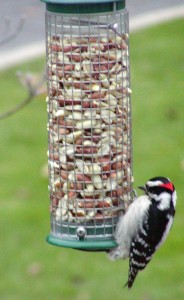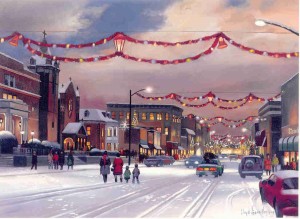
How would you like to live in a town that decks itself out like this for the holidays? Lucky me, I do! Technically, I live in the next town over, but Red Bank is the place that I consider home. I don’t really feel part of the community in the town where I live, but feel as if I’m among friends when going about my daily grind in Red Bank. There’s always a familiar face and I know the best coffee shops and where to find a good bargain in town.
My husband was born and raised in Red Bank and has worked for the Public Works Department there for most of his adult life. He fixes the police cars and fire trucks (and is a volunteer fireman there), picks up the leaves in fall, and plows the snow off the streets in the wintertime. If you want to know the truth, I think the town would crumble and fall without him, at least judging by the number of calls he gets to go into work at 3 am to fix something.
Another *job* that my DH has is to decorate the town for the holidays; he’s done this for as long as I can remember. During November he works his regular job during the day and then spends a few hours each night and most days on the weekends stringing lights and hanging wreaths around town. By the time Thanksgiving comes and the work is done he’s about had it with decorating, but that is when we start the job of decorating our own home for Christmas. Some years he’s full of energy and goes all out at home, other years we’re lucky to get a tree up and decorated before midnight on Christmas Eve.
This year, my DH decided that he wants a break and won’t be doing the decorating in Red Bank. He says he’s tired of working out in the cold and the rain. It’s strange to have him here now, when he should be out there, making the town light up so pretty. Already tonight, as the deadline nears, the phone calls are coming for him to help, or to fix some machine that’s stuck in the road blocking traffic. I’m sure he won’t be able to resist helping, for long.
The image above is a scan of a Christmas card from a few years ago. A local artist paints beautiful scenes of the town at Christmas and turns some into cards. One day I’d like to be able to afford one of his paintings of a Christmas scene of our hometown as a gift for my husband. Something beautiful to remember all of his hard work by.
Worms before dinner
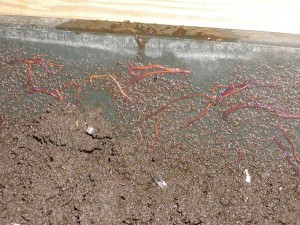 It dawned on me this afternoon that I haven’t checked on the worms in the basement for a while. I add food to the bin once a week, but lately that’s it. I’ve not been a very good landlord, it seems.
It dawned on me this afternoon that I haven’t checked on the worms in the basement for a while. I add food to the bin once a week, but lately that’s it. I’ve not been a very good landlord, it seems.
If you need reminding, I keep a worm bin in the basement to compost kitchen scraps. It’s a small tray-type bin and the worms are red wigglers. It’s not nearly as disgusting as it sounds. I collect leftover vegetables and greens, coffee grounds, and eggshells in a small copper composting bucket I keep in the kitchen and once a week empty it into the bin for the worms. I cover the food with a layer of shredded junk mail so there is no smell to attract other insects. Every few months the worms have made enough compost for me have a few cups worth of natural fertilizer for my houseplants. Mostly I save the compost up and use it in the spring when I repot.
If things are working as they should there is no smell or trouble with it at all. I usually add food to the bottom tray until it looks nearly *done* and then add food to the next tray up, with the idea that the worm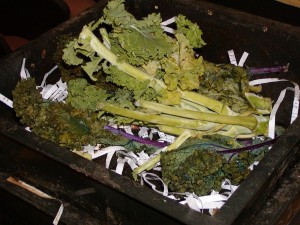 s will move upward to find the food, leaving the compost in the tray below free of worms.. My worms didn’t want to migrate upward like they were supposed to, so this year I’ve been adding food to the bottom tray, hoping that they’ll be willing instead to migrate downward. So far it seems to be working, except for the few worms in the opening photo who look like they’re trying to migrate up and out of the bin! Excess moisture has always been a problem for me and even that top tray of nearly finished compost is wetter than it should be.
s will move upward to find the food, leaving the compost in the tray below free of worms.. My worms didn’t want to migrate upward like they were supposed to, so this year I’ve been adding food to the bottom tray, hoping that they’ll be willing instead to migrate downward. So far it seems to be working, except for the few worms in the opening photo who look like they’re trying to migrate up and out of the bin! Excess moisture has always been a problem for me and even that top tray of nearly finished compost is wetter than it should be.
I suspect that adding food to the lowest tray, so near to the bottom of the set-up, is what’s causing the backup of excess moisture in the system. There’s a spigot on the bottom to drain away the liquid, so I’ve left it open with my copper bucke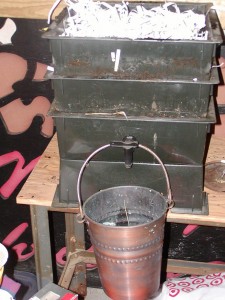 t beneath it to hopefully dry things out. They say that you should be able to use the liquid that drains out as *compost tea*, but I find it to be so foul-smelling that I would never want it on the houseplants anywhere near where I was sitting! Usually I’ll just dump it outside on the vegetable garden far away from the house.
t beneath it to hopefully dry things out. They say that you should be able to use the liquid that drains out as *compost tea*, but I find it to be so foul-smelling that I would never want it on the houseplants anywhere near where I was sitting! Usually I’ll just dump it outside on the vegetable garden far away from the house.
I decided to try adding some dry leaves as bedding, in addition to the shredded paper and junk mail, for added minerals for the worms. The instructions that came with my bin suggest adding all sorts of oddball things. Every so often I try something new and hope for the best. The worms don’t really eat the garbage; instead they feed on the microorganisms that decay the food – so I won’t add anything that is likely to rot and fester in there for too long – no meat or oil in any form. Once in a while I’ll treat them with some moldy bread or baking yeast sprinkled on top of the working tray, but that’s it. They seem to be happy with old bunny greens. In fact, I see lots of little red worms if anybody wants to give vermicomposting a try!
Carpintero velloso menor
By any other name – a bird quiz
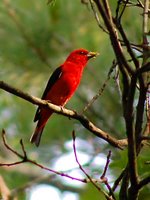 NJ Audubon has recently published a guide to the New Jersey Meadowlands that is available for free. This guide is the second in a series; the first covers the NJ Delaware Bayshore. These are great little books! I mention them now because on my most recent volunteer day at Sandy Hook Bird Observatory I discovered that the new guide had finally arrived, but for some reason, we only had the Spanish-language version in stock. While I’m glad to see that it’s being published in Spanish, I do wonder how many Spanish-speaking birders there are out there to make use of it.
NJ Audubon has recently published a guide to the New Jersey Meadowlands that is available for free. This guide is the second in a series; the first covers the NJ Delaware Bayshore. These are great little books! I mention them now because on my most recent volunteer day at Sandy Hook Bird Observatory I discovered that the new guide had finally arrived, but for some reason, we only had the Spanish-language version in stock. While I’m glad to see that it’s being published in Spanish, I do wonder how many Spanish-speaking birders there are out there to make use of it.
The language teacher and word-lover in me was most interested in how the translators of the guide handled the use of bird names in Spanish. From the little bit that I’ve read on the subject, there currently is no standard method for this type of translation due to the many local variants that are commonly used for bird names. I believe that this guide makes use of the names used in the Spanish version of the Kaufman Field Guide to Birds.
Anyway…. I thought we might have a little fun with this. Translation is more art than science, and involves finding the essence of what a thing is, rather than focusing on the words used to describe it. In other words, a thing is what it is, rather than what it’s called. Many bird names in English seem arbitrary on the surface, but often relate to some characteristic of the bird in question, whether the name be related to how the bird looks or how it feeds or the sound of its voice. For example, the name of the White-breasted Nuthatch describes the bird’s physical appearance as well as making reference to its feeding behavior. The name of the Northern Cardinal likens its color to the vestments worn by some priests. The name of the Scarlet Tanager in part is descriptive of the bird’s color, but what does tanager refer to? Is that an arbitrary term? Couldn’t we just as easily call the Scarlet Tanager the Black-winged Redbird? Would we still know it by that name?
Never having had occasion to use Spanish bird names, I sat down with my dictionary this evening to dissect the Spanish names of a few birds and thought it might make a fun quiz for bird lovers. The 15 bird names that follow are literal translations of the Spanish used to describe them. Similar species are loosely grouped together.
1. Scratching sparrow
2. Chestnut-colored pouch-maker
3. Red-eyed scratcher
4. Fuzzy little carpenter
5. Little whistling plover
6. Orange-throated warbler
7. Blazing/fluttering warbler
8. Sideburned warbler
9. Ground warbler
10. Creeping warbler
11. Spotted thrush
12. Golden-toed egret
13. Scissor-tailed swallow
14. Rainbow duck
15. Nun-like duck
Some of these are very easy, with others you may have to use your imagination. Some bird names were impossible to translate so literally without giving them away, often because the name, like our English one, related to the bird’s call. For example, the Killdeer is called Chorlo Tildío; Chorlo is the family name of Plover, Tildío is the descriptive term and sounds (even in Spanish!) like the Killdeer’s call. Similarly, the Willet is called Playero Pihuihui; Playero is the family name and Pihuihui describes the Willet’s call.
Happy guessing!
Image of the Black-winged Redbird from http://www.flickr.com/photos/trombamarina/179428016/
11/16/06 Mid-week bunny fix
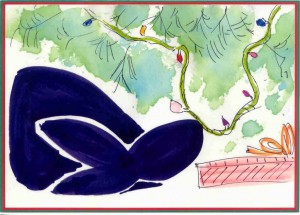 Just passing along a link to a favorite bunny site this week. If you’re looking for bunny-themed holiday cards or what-have-you check out Rabbitt in Paradise. Blackberry Bunny lives at the beach in Hawaii.
Just passing along a link to a favorite bunny site this week. If you’re looking for bunny-themed holiday cards or what-have-you check out Rabbitt in Paradise. Blackberry Bunny lives at the beach in Hawaii. Friends and companions (Renga)
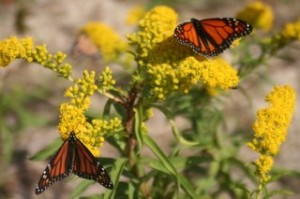
urgency of bloom
hurry to flower and seed
fuel for the migrants
Autumn’s children moving south
in flocks like sunset-colored clouds
A rather loose interpretation of this week’s theme for one deep breath. A Renga is a group-effort sort of poem, written with others. I may try to get the girls at work to help me on another one, like Jane Poe – Nevermore did. Stay tuned.
**Updated: I harassed some of my coworkers into writing a Renga today, as stress relief. Their group effort follows.
In other news, my big brother stopped by here long enough to razz me about being Daddy’s Little Girl. Check the comments on this post.
Honey, I think it’s done
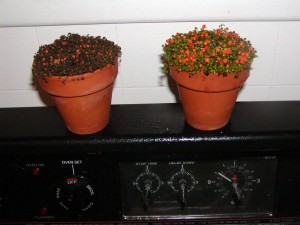 We had my favorite for dinner on Sunday night – Spaghetti! Pasta is more or less a forbidden food here since my husband found out a few years ago that he has diabetes. I love pasta and bread more than anything, except cheese, and miss eating it. I hardly ever get to have it for lunch even, because my lunch-buddy Deb makes me eat healthy salads everyday.
We had my favorite for dinner on Sunday night – Spaghetti! Pasta is more or less a forbidden food here since my husband found out a few years ago that he has diabetes. I love pasta and bread more than anything, except cheese, and miss eating it. I hardly ever get to have it for lunch even, because my lunch-buddy Deb makes me eat healthy salads everyday.
We decided to cheat, just once, because I was craving Spaghetti. I was totally decadent and bought nice Italian bread and whole milk ricotta cheese to mix with the pasta. Heavenly!
The DH ended up in charge of cooking while I wandered off to do something else. While I was cleaning up the dishes and stove I discovered the poor charred houseplants that I had left on top of the stove to drain. The one on the right is more or less okay, just a little singed around the edges, but the other is totally baked. I wonder, do you think it will recover? 😉
If you’re interested, the plant is called a Pin Cushion Plant or Coral Bead Plant (Nertera granadensis) and is a weird little houseplant in the madder family sold around Halloween. I read that it’s native to moist, boggy places in New Zealand and Tasmania. Apparently, it doesn’t do well on the stove, despite all the steam from the boiling pasta.
Little Lessons from Dad

Have you ever sat down and tried to make a list of all the things you’ve learned from your parents? Aside from the *important* things, what are those little lessons that we learn by example? The (sometimes) inconsequential things that we remember a parent for?
-
Convince your daughter to have the expensive wedding. Worry later how you’ll pay for it.
-
A good story deserves to be retold.
-
A father is his daughter’s fiercest protector. While the daughter may not appreciate all that yelling and screaming on her behalf (especially if she’s a teenager) she should allow it to happen and be glad for his protection, because one day he won’t be there to do it.
-
Do something with all those National Geographic magazines you’ve been saving in the garage, before you die, so that your kids won’t have to feel bad about throwing them away.
-
Pending loss and grief give rise to new friendships and make clear those that should give way.
-
Stamp your feet when you’re angry. Your kids will remember you for it and laugh.
-
Let people take care of you when you need caring for. It helps them, even if it doesn’t make you feel any better.
-
Mispronounce words, often.
-
Cooking sun-dried tomatoes, Jamaican beef patties, or hearts of palm will cause raised eyebrows at the dinner table. Getting angry about it will only make your kids laugh more. (When you’re not looking, of course!)
- Believe in life, always.
Because I needed to hear it today, the second anniversary of my dad’s passing, NPR’s All Things Considered aired a wonderful audio segment about a father and daughter called A Father’s Last Days. It was a sweet and sad reminder of the final months of my dad’s life and made me wish that I’d had the strength, humor, and foresight that Adrian had when helping her dad face the end of his life. Worth a listen, but have a tissue handy.
New suet feeder!
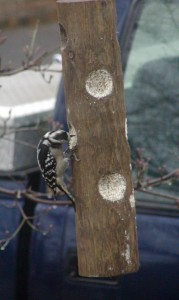 This is a new suet feeder that I bought a few weeks ago at Wild Birds Unlimited – it doesn’t seem to have a catchy name, but then it’s just a hunk of wood with a few holes drilled where you stuff the suet. Mine came pre-filled, but when the birds have emptied it, the store sells new suet plugs.
This is a new suet feeder that I bought a few weeks ago at Wild Birds Unlimited – it doesn’t seem to have a catchy name, but then it’s just a hunk of wood with a few holes drilled where you stuff the suet. Mine came pre-filled, but when the birds have emptied it, the store sells new suet plugs.
Suet provides extra calories that birds use to keep warm during the winter. Some people also feed suet during the summer, but I don’t do much bird-feeding then, other than the goldfinches.
The birds ignored the new feeder for a few weeks; it’s only in the last few days that it’s getting any action. The starlings and grackles are staying away for now, and the squirrels are, too. (I probably just jinxed myself by saying that…)
I’m hoping that the chickadees, titmice, nuthatches, and even the Carolina Wrens will use this feeder, in addition to the woodpeckers. So far I’ve only seen the Downies at it, but the other birds are more interested in the new peanut feeder. I spent an hour or so this afternoon watching the jays and titmice come and go. There were even a few white-throated sparrows carrying off the peanut tidbits dropped by the bigger birds above them.
I would love to see a Pileated Woodpecker at this feeder, but they’re not in this area. Who knows, maybe they are and I just haven’t spotted one yet. Pileateds are another nemesis bird of mine.
While this isn’t a great pic, you can see how this female (no red cap) is using her tail feathers to prop herself against the feeder, the same way she would do while feeding in a tree. I had wondered if birds would find anything to grip onto with this feeder, because the surface is so smooth, but it looks as though she has her feet gripped onto the lip of the suet plug.
Whispering goodnight
 Borland compares the fallen leaves to a colorful patchwork quilt of reds, tans, and yellows ready to blanket the earth and protect seed and root from frost until later in the season when it will be sheltered with a layer of glistening snow.
Borland compares the fallen leaves to a colorful patchwork quilt of reds, tans, and yellows ready to blanket the earth and protect seed and root from frost until later in the season when it will be sheltered with a layer of glistening snow.
If we think of Spring as the morning of the year, then now is the evening, the bedtime of the green and flowering world. So, says Borland, the coverlet is spread and the tucking in begun. All that remains is someone to sing a lullaby to the earth, but the singers have all gone south. Who will whisper good night to the earth?
Part of my routine each morning is to read the daily entry in Borland’s Sundial of the Seasons. Yesterday’s entry, besides creating a wonderul image of the world being tucked in to sleep for the winter, reminded me of my childhood and the bedtime routine of being tucked in by mom or dad and saying my prayers:
Now I lay me down to sleep, I pray the Lord my soul to keep,
If I should die before I wake, I pray the Lord my soul to take.
I was also taught to add a request for blessings after that:
God bless mommy and daddy, grandma and grandpop, friends and brothers, and ….
Funny how I can still remember that so clearly, and that I remember adding people and animals onto the end of that list. I can almost imagine my mom or dad wishing I would hurry up already so that they could get on with whatever they needed to do and be finished with tucking me in. The most important part of the routine, once prayers were said, was that the bedroom door be left open and the hall light be on. I was scared of the dark and the things that lurked under my tall canopy bed. I loved to hide under there during the daylight hours, but at night it was inhabited by monsters just waiting to drag a little girl under by an arm draped casually over the bedside.
Whenever it was that I was old enough to sleep without the hall light on and too old to be tucked in, the bedtime routine changed to a personal one, with prayers whispered to myself and a goodnight kiss for my dad, who was usually up at all hours of the night working on the computer.
I must’ve learned from him to be a night owl, because I’m the last to bed each night, turning off the lights and saying goodnight to the bunnies and then the dog who is fast asleep beside my husband on the bed. I shoo him off to his own comfy bed and climb into the warm spot he left behind, wishing for someone to tuck the blanket under my chin and then whisper goodnight when my prayers are finished.
